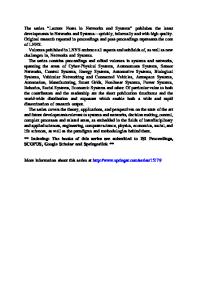Sketching Bitcoin: Empirical Research of Digital Affordances
Velasco discusses contemporary literature on Bitcoin and distinguish between technical and social research, in an effort to provide a basis for identifying native social structures within this digital assemblage. The chapter is particularly interested in
- PDF / 632,360 Bytes
- 24 Pages / 419.53 x 595.28 pts Page_size
- 3 Downloads / 297 Views
Sketching Bitcoin: Empirical Research of Digital Affordances Pablo R. Velasco Bitcoin was originally a protocol to avoid double spending in a decentralized and public payment system, proposed in 2008 by someone known by the pseudonym of Satoshi Nakamoto. Alongside the protocol she/he unveiled a first working version of the source code to implement the payment system. The necessary preconditions for its materialization, however, had been developed at least since the 1970s: the advancements in cryptographic techniques embodied in Bitcoin (for instance, Merkle trees, Blind signatures, Elliptic Curve Digital Signature Algorithm), both failed and successful attempts at the creation of digital cash (for example, Digicash, Mondex, B-money, Bitgold), and the 1990s cypherpunk political atmosphere contributed directly and indirectly to the emergence of cryptocurrencies. The system was slowly adopted by small cryptographic communities at first, both for its state-of-the-art design regarding security and anonymity (highly praised characteristics within the community) and for its speculative potential. It was this last attribute that attracted many people after Bitcoin achieved a somewhat more mainstream status when it achieved parity with the US dollar. The same year saw the appearance of Mt. Gox (a Bitcoin market exchange) and Silk Road (a digital black market), two of
P.R. Velasco () University of Warwick, Coventry, UK e-mail: [email protected] © The Author(s) 2016 S. Kubitschko, A. Kaun (eds.), Innovative Methods in Media and Communication Research, DOI 10.1007/978-3-319-40700-5_6
99
100
P.R. VELASCO
the most controversial phenomena related to Bitcoin, and the recognition of it as a solid alternative payment system by WikiLeaks and the Electronic Frontier Foundation. Media attention and government concerns grew from 2011 to the end of 2013, when the value of a bitcoin exceeded US $1000. Today, the Bitcoin market capitalization floats at around $3.5 billion. Its success is difficult to measure, in part because of its novelty and also because of its shady behavior (even though transactions are public, no names, places, or reasons are attached to them). The technology behind it is also spreading to applications where the monetary characteristics are not a goal but a means to another end (for example, smart contracts). At this point of Bitcoin’s evolution it carries a huge potential to shape a significant part of the digital horizon, thus making it a suitable, if not necessary, research object to understand contemporary networked society. While much research has been devoted to its instrumental improvements and weaknesses, only a few studies have aimed to investigate the social and political aspects of cryptocurrencies. As a first step I will therefore discuss contemporary literature on Bitcoin and distinguish between technical and social research, in an effort to provide a basis for identifying native social structures within this digital assemblage. I am particularly interested in digital research spro
Data Loading...











